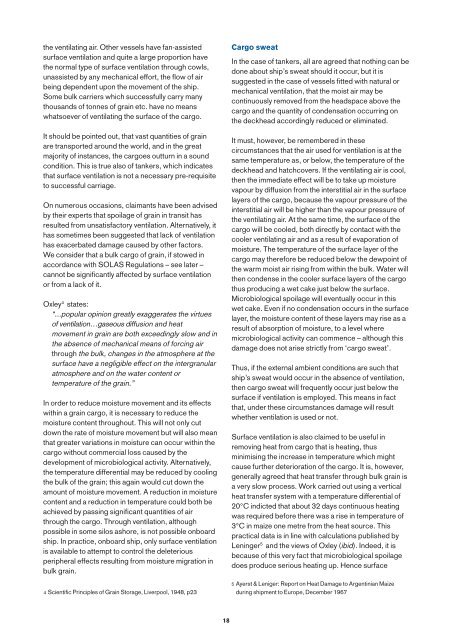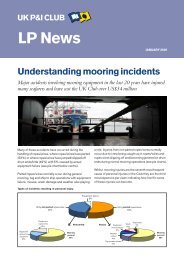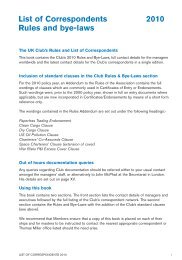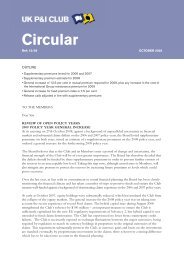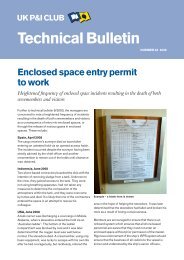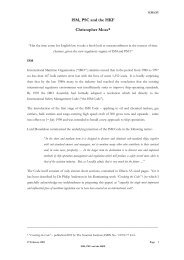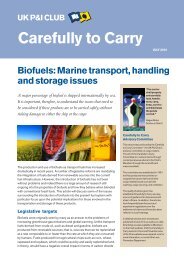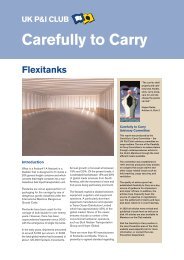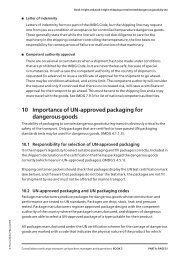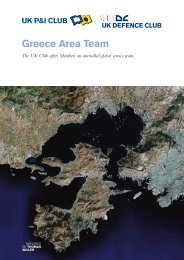Bulk Matters - UK P&I
Bulk Matters - UK P&I
Bulk Matters - UK P&I
You also want an ePaper? Increase the reach of your titles
YUMPU automatically turns print PDFs into web optimized ePapers that Google loves.
the ventilating air. Other vessels have fan-assisted<br />
surface ventilation and quite a large proportion have<br />
the normal type of surface ventilation through cowls,<br />
unassisted by any mechanical effort, the flow of air<br />
being dependent upon the movement of the ship.<br />
Some bulk carriers which successfully carry many<br />
thousands of tonnes of grain etc. have no means<br />
whatsoever of ventilating the surface of the cargo.<br />
It should be pointed out, that vast quantities of grain<br />
are transported around the world, and in the great<br />
majority of instances, the cargoes outturn in a sound<br />
condition. This is true also of tankers, which indicates<br />
that surface ventilation is not a necessary pre-requisite<br />
to successful carriage.<br />
On numerous occasions, claimants have been advised<br />
by their experts that spoilage of grain in transit has<br />
resulted from unsatisfactory ventilation. Alternatively, it<br />
has sometimes been suggested that lack of ventilation<br />
has exacerbated damage caused by other factors.<br />
We consider that a bulk cargo of grain, if stowed in<br />
accordance with SOLAS Regulations – see later –<br />
cannot be significantly affected by surface ventilation<br />
or from a lack of it.<br />
Oxley 4 states:<br />
“...popular opinion greatly exaggerates the virtues<br />
of ventilation…gaseous diffusion and heat<br />
movement in grain are both exceedingly slow and in<br />
the absence of mechanical means of forcing air<br />
through the bulk, changes in the atmosphere at the<br />
surface have a negligible effect on the intergranular<br />
atmosphere and on the water content or<br />
temperature of the grain.”<br />
In order to reduce moisture movement and its effects<br />
within a grain cargo, it is necessary to reduce the<br />
moisture content throughout. This will not only cut<br />
down the rate of moisture movement but will also mean<br />
that greater variations in moisture can occur within the<br />
cargo without commercial loss caused by the<br />
development of microbiological activity. Alternatively,<br />
the temperature differential may be reduced by cooling<br />
the bulk of the grain; this again would cut down the<br />
amount of moisture movement. A reduction in moisture<br />
content and a reduction in temperature could both be<br />
achieved by passing significant quantities of air<br />
through the cargo. Through ventilation, although<br />
possible in some silos ashore, is not possible onboard<br />
ship. In practice, onboard ship, only surface ventilation<br />
is available to attempt to control the deleterious<br />
peripheral effects resulting from moisture migration in<br />
bulk grain.<br />
4 Scientific Principles of Grain Storage, Liverpool, 1948, p23<br />
Cargo sweat<br />
In the case of tankers, all are agreed that nothing can be<br />
done about ship’s sweat should it occur, but it is<br />
suggested in the case of vessels fitted with natural or<br />
mechanical ventilation, that the moist air may be<br />
continuously removed from the headspace above the<br />
cargo and the quantity of condensation occurring on<br />
the deckhead accordingly reduced or eliminated.<br />
It must, however, be remembered in these<br />
circumstances that the air used for ventilation is at the<br />
same temperature as, or below, the temperature of the<br />
deckhead and hatchcovers. If the ventilating air is cool,<br />
then the immediate effect will be to take up moisture<br />
vapour by diffusion from the interstitial air in the surface<br />
layers of the cargo, because the vapour pressure of the<br />
interstitial air will be higher than the vapour pressure of<br />
the ventilating air. At the same time, the surface of the<br />
cargo will be cooled, both directly by contact with the<br />
cooler ventilating air and as a result of evaporation of<br />
moisture. The temperature of the surface layer of the<br />
cargo may therefore be reduced below the dewpoint of<br />
the warm moist air rising from within the bulk. Water will<br />
then condense in the cooler surface layers of the cargo<br />
thus producing a wet cake just below the surface.<br />
Microbiological spoilage will eventually occur in this<br />
wet cake. Even if no condensation occurs in the surface<br />
layer, the moisture content of these layers may rise as a<br />
result of absorption of moisture, to a level where<br />
microbiological activity can commence – although this<br />
damage does not arise strictly from ‘cargo sweat’.<br />
Thus, if the external ambient conditions are such that<br />
ship’s sweat would occur in the absence of ventilation,<br />
then cargo sweat will frequently occur just below the<br />
surface if ventilation is employed. This means in fact<br />
that, under these circumstances damage will result<br />
whether ventilation is used or not.<br />
Surface ventilation is also claimed to be useful in<br />
removing heat from cargo that is heating, thus<br />
minimising the increase in temperature which might<br />
cause further deterioration of the cargo. It is, however,<br />
generally agreed that heat transfer through bulk grain is<br />
a very slow process. Work carried out using a vertical<br />
heat transfer system with a temperature differential of<br />
20°C indicted that about 32 days continuous heating<br />
was required before there was a rise in temperature of<br />
3°C in maize one metre from the heat source. This<br />
practical data is in line with calculations published by<br />
Leninger 5 and the views of Oxley (ibid). Indeed, it is<br />
because of this very fact that microbiological spoilage<br />
does produce serious heating up. Hence surface<br />
5 Ayerst & Leniger: Report on Heat Damage to Argentinian Maize<br />
during shipment to Europe, December 1967<br />
18


